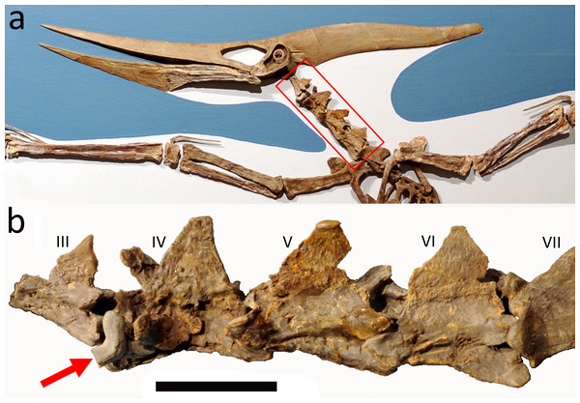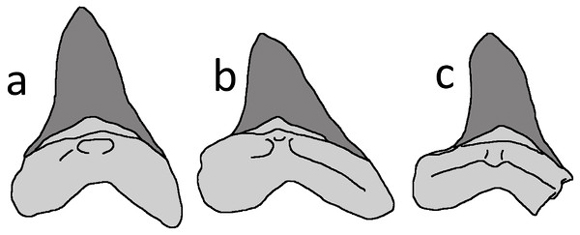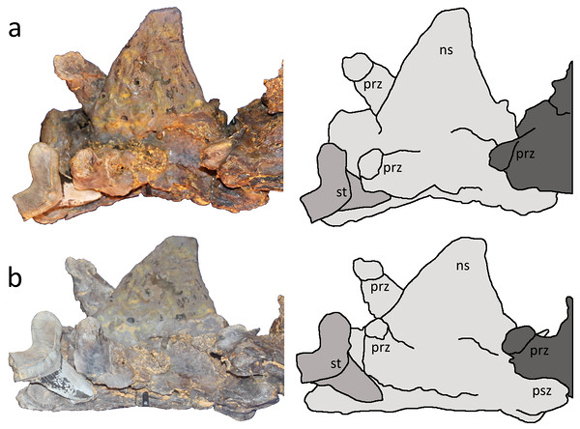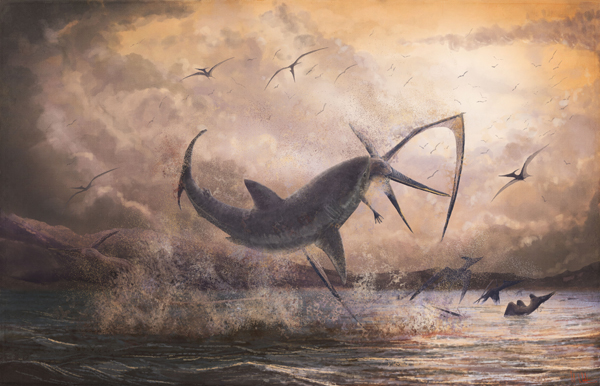Evidence That Sharks Fed on Pterosaurs Identified in New Research
Cretoxyrhina Tooth Embedded in the Neck of a Pteranodon
There has been quite a lot of media coverage this week, following the publication of a scientific paper that described the interaction between a shark from the Western Interior Seaway (Cretoxyrhina mantelli) and a pterosaur (Pteranodon). A single tooth from the shark, was discovered wedged against the fourth cervical vertebra (fourth bone in the neck), of the flying reptile. The association of the tooth and its proximity to the vertebra suggests that the preservation of bone and tooth together was more than mere coincidence. The specimen is evidence of a Cretoxyrhina shark biting a Pteranodon.
Evidence for a Shark Bite on the Neck of a Pterosaur

Picture credit: (A) Stephanie Abramowicz, courtesy Dinosaur Institute, Natural History Museum of Los Angeles County, (B) David Hone
The Pteranodon specimen is housed in a glass case at the Los Angeles Museum of Natural History, so the researchers, David Hone (University of London), Mark Witton (Portsmouth University) and Michael Habib (University of Southern California), had difficulty in obtaining direct access to the fossils. However, undeterred they made measurements of the embedded fossil tooth and it is estimated to be 24 mm high (root plus crown) and its morphology suggests that it came from a well-known lamniform shark from the Western Interior Seaway – C. mantelli.
Based on the tooth dimensions, the shark is estimated to have been around 2.5 metres long, big, but not as large as some Cretoxyrhina mantelli specimens, this species of Late Cretaceous shark is believed to have reached lengths of around seven metres, making it larger than the extant Great White (C. carcharias).
Identifying the Attacker
Teeth associated with lamniform sharks are particularly common in marine deposits associated with the Western Interior Seaway. The morphology of the tooth suggests that this tooth came from Cretoxyrhina mantelli and this fossil specimen (LACM 50926), is the first documented occurrence of this large shark interacting with any type of flying reptile.
Typical Teeth Morphologies Associated with C. mantelli

Picture credit: David Hone
Evidence of Cretoxyrhina Biting Pteranodon
It is not possible to state categorically, whether the fossil specimen (LACM 50926), is evidence of predation or whether the shark took a bite out of a Pteranodon carcase. Several examples of Cretoxyrhina spp. feeding traces are known on the fossilised remains of other vertebrates from the Western Interior Seaway. In addition, there is evidence to suggest other types of fish, including sharks, consumed Pteranodon. This is the first example of an interaction between Cretoxyrhina and “toothless wing”.
A Close-up View of the Neck Bone and the Shark Tooth

Picture credit: David Hone
Spectacular Palaeoart
One of the co-authors of the paper, Mark Witton, is a highly respected palaeoartist, as well as an authority on the Pterosauria. He has produced a stunning illustration of a Cretoxyrhina shark leaping out of the water as it bites the neck of a Pteranodon.
A Large Pteranodon Meets Its End in the Jaws of a Cretoxyrhina Shark

Picture credit: Mark Witton
Pteranodon is widely believed to have foraged for small fish and other aquatic prey by alighting on the water and dip-feeding. Once on the surface of the sea, it would have been within the reach of predatory sharks, although whether the breaching Cretoxyrhina portrayed by Mark Witton accurately depicts an attack by the shark on a pterosaur is open to speculation. However, the image is visually stunning and as marine seabirds today are actively predated by sharks, an example being Tiger sharks attacking fledgling albatross chicks, such a dramatic scene could have taken place on the waters of the Western Interior Seaway.
However, the tooth in association with the cervical vertebra could have resulted from the scavenging of a pterosaur carcase.
Not All That it Seems
The Pteranodon fossil in the display case is not all that it seems. Like many museum specimens, it is a composite, it is made up of bones from several animals to help make the skeleton more complete. Furthermore, part of the fossil display is genuine, but numerous elements have been reconstructed to replace absent parts.
The authors note that the preservation quality and size of the vertebrae correspond well to the other elements (including the forelimb bones) and this implies that LACM 50926 may represent much of a skeleton. However, the absence of both anteriormost and posterior cervical vertebrae means no anatomical continuity links the 50926 vertebrae with the rest of the material and subsequently, their association to the rest of the skeleton cannot be stated confidently.
A Link Between a Feeding Cretoxyhina and a Pteranodon
With all this said, LACM 50926 is the first palaeoecological link between a feeding Cretoxyrhina mantelli and a Pteranodon. Such evidence of interactions like this are very rare in the fossil record. Pteranodon seems to have been a relatively common flying reptile, it makes up some 97% of the Niobrara Formation pterosaur fossil finds. Sharks feeding on large pterosaurs such as Pteranodon may have been a more frequent occurrence, but the hollow bones of these flying reptiles may have broken quite easily when subjected to the biteforce of a shark and so the likelihood of any fossil evidence being preserved would be diminished. Chances are the evidence of such interactions just got consumed.
The scientific paper: “Evidence for the Cretaceous Shark Cretoxyrhina mantelli feeding on the pterosaur Pteranodon from the Niobrara Formation” by David W. E. Hone, Mark P. Witton and Michael B. Habib and published in the open access journal PeerJ.
Visit the Everything Dinosaur website: Everything Dinosaur.

